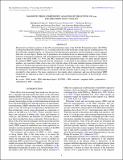Files in this item
Magnetic field components analysis of the SCUPOL 850 μm polarization data catalog
Item metadata
| dc.contributor.author | Poidevin, F. | |
| dc.contributor.author | Falceta-Gonçalves, D. | |
| dc.contributor.author | Kowal, G. | |
| dc.contributor.author | De Gouveia Dal Pino, E. | |
| dc.contributor.author | Magalhães, A.M. | |
| dc.date.accessioned | 2014-09-25T12:01:04Z | |
| dc.date.available | 2014-09-25T12:01:04Z | |
| dc.date.issued | 2013-11-10 | |
| dc.identifier | 151129145 | |
| dc.identifier | 88d06e7a-28bf-4a34-b4ad-e24336799539 | |
| dc.identifier | 84886694703 | |
| dc.identifier.citation | Poidevin , F , Falceta-Gonçalves , D , Kowal , G , De Gouveia Dal Pino , E & Magalhães , A M 2013 , ' Magnetic field components analysis of the SCUPOL 850 μm polarization data catalog ' , Astrophysical Journal , vol. 777 , no. 2 , 112 . https://doi.org/10.1088/0004-637X/777/2/112 | en |
| dc.identifier.issn | 0004-637X | |
| dc.identifier.uri | https://hdl.handle.net/10023/5498 | |
| dc.description | D.F.G. thanks the European Research Council (ADG-2011 ECOGAL), and brazilian agencies CNPq (No. 300382/2008-1), CAPES (3400-13-1) and FAPESP (No. 2011/12909-8) for financial support. | en |
| dc.description.abstract | We present an extensive analysis of the 850 μm polarization maps of the SCUBA Polarimeter Legacy (SCUPOL) Catalogue produced by Matthews et al., focusing exclusively on the molecular clouds and star-forming regions. For the sufficiently sampled regions, we characterize the depolarization properties and the turbulent-to-mean magnetic field ratio of each region. Similar sets of parameters are calculated from two-dimensional synthetic maps of dust-emission polarization produced with three-dimensional magnetohydrodynamics (MHD) numerical simulations scaled to the S106, OMC-2/3, W49, and DR21 molecular cloud polarization maps. For these specific regions, the turbulent MHD regimes retrieved from the simulations, as described by the turbulent Alfvén and Sonic Mach numbers, are consistent within a factor one to two with the values of the same turbulent regimes estimated from the analysis of Zeeman measurements data provided by Crutcher. Constraints on the values of the inclination angle α of the mean magnetic field with respect to the line of sight are also given. The values obtained from the comparison of the simulations with the SCUPOL data are consistent with the estimates made by using two observational methods provided by other authors. Our main conclusion is that simple, ideal, isothermal, and non-self-gravitating MHD simulations are sufficient in order to describe the large-scale observed physical properties of the envelopes of this set of regions. | |
| dc.format.extent | 15 | |
| dc.format.extent | 720925 | |
| dc.language.iso | eng | |
| dc.relation.ispartof | Astrophysical Journal | en |
| dc.rights | © 2013. The American Astronomical Society. All rights reserved. | en |
| dc.subject | ISM: clouds | en |
| dc.subject | ISM: individual objects: SCUPOL | en |
| dc.subject | ISM: structure | en |
| dc.subject | Magnetic fields | en |
| dc.subject | Polarization | en |
| dc.subject | Submillimeter: ISM | en |
| dc.subject | Turbulence | en |
| dc.subject | QB Astronomy | en |
| dc.subject | QC Physics | en |
| dc.subject.lcc | QB | en |
| dc.subject.lcc | QC | en |
| dc.title | Magnetic field components analysis of the SCUPOL 850 μm polarization data catalog | en |
| dc.type | Journal article | en |
| dc.contributor.sponsor | European Research Council | en |
| dc.contributor.institution | University of St Andrews.School of Physics and Astronomy | en |
| dc.identifier.doi | 10.1088/0004-637X/777/2/112 | |
| dc.description.status | Peer reviewed | en |
| dc.identifier.grantnumber | en |
This item appears in the following Collection(s)
Items in the St Andrews Research Repository are protected by copyright, with all rights reserved, unless otherwise indicated.

